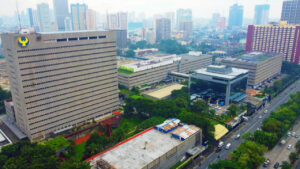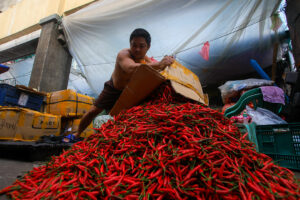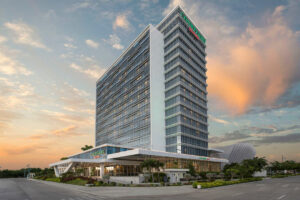Philippine banks optimistic on growth prospects
THE PHILIPPINE banking industry is optimistic on its growth prospects over the next two years, a Bangko Sentral ng Pilipinas’ (BSP) survey showed. Results of the central bank’s 2023 Banking Sector Outlook Survey (BSOS) showed that banks expect “double-digit growth in their assets, loans, deposits, and net income, as well as plan to maintain robust […]

THE PHILIPPINE banking industry is optimistic on its growth prospects over the next two years, a Bangko Sentral ng Pilipinas’ (BSP) survey showed.
Results of the central bank’s 2023 Banking Sector Outlook Survey (BSOS) showed that banks expect “double-digit growth in their assets, loans, deposits, and net income, as well as plan to maintain robust capital and liquidity positions to maintain institutional stability.”
“Overall, the industry outlook for the next two years remains upbeat amid macroeconomic challenges experienced in 2023,” it added.
The survey covers all BSP-supervised universal and commercial banks (U/KBs) and thrift banks, as well as 80 rural and cooperative banks (RCBs) and five digital banks (DGBs).
These respondent banks accounted for 97.7% of the total assets of the Philippine banking system as of December 2023, the BSP said.
The survey showed there was a “shift in sentiment towards a stronger banking system outlook.”
The majority of respondent lenders (64.6%) expect a “stable” banking system in the next two years, while 34.7% expect a “stronger” banking system.
The BSP said improved economic prospects contributed to banks’ expectations of sustained double-digit growth in their assets.
Latest central bank data showed that the total resources of the Philippine financial system rose by 10.5% to P32.1 trillion at end-July. Banking resources alone climbed by 12.3% to P26.779 trillion year on year.
The survey noted that a bigger percentage of banks (70.1% from 66.9% previously) forecast double-digit asset growth, largely driven by thrift banks and digital banks.
“In particular, 79.4% of thrift banks expect an asset expansion of above 10%, while all digital banks believe asset growth could go up to more than 20%.”
“As for other banking groups, U/KBs’ are divided, with 50% (from 42.1%) expecting asset growth of between 5% and 10%, and the remaining half (from 57.9%) projecting 10% to 15% growth. Most RCBs, and foreign banks expect their assets to grow at a rate between 10% and 15%, relatively unchanged from the 2022 BSOS.”
Banks also expect lending activity to be a key driver of their operations in the next two years, with 82.2% (from 78.7%) expecting double-digit loan growth, the BSP said.
“U/KBs, thrift banks, and RCBs mostly report a 10% to 15% loan growth, while most foreign banks and all DGBs remain optimistic with loan growth projection of over 20%,” it added.
BSP data showed that bank lending rose by 10.4% year on year to P12.14 trillion in July. This was its fastest growth in 19 months or since the 13.7% logged in December 2022.
Loan quality is also seen to further improve amid the country’s continued economic recovery, according to the survey, with a lower percentage of banks (48.7% from 52.4%) expecting their nonperforming loan (NPL) ratio to be above 5% in the next two years.
“The remaining 29.4% and 21.9% believe their NPL ratio [would] settle below 3%, and between 3% and 5%, respectively,” the central bank added.
Broken down, 84.6% of U/KBs see their NPL ratio settling between 1% and 5%, with significantly more U/KBs (38.5% from 5.6%) expecting their bad loan ratio to range from 1% to 2%.
“For thrift banks, RCBs, and digital banks, majority foresee their NPL ratio to be over 5%, almost similar to their 2022 BSOS projection. In contrast, foreign banks are more optimistic, as 50% (same at 50%) maintain an NPL ratio projection of less than 1%, while 20% (from nil) expect their NPL ratio to range from 2 to 3%.”
Meanwhile, 76.5% of respondent banks (down from 77.9%) expect double-digit growth in net income over the next two years.
“Profitability prospects remain encouraging on the back of a high interest rate environment and improving macroeconomic conditions,” the BSP added.
“Healthy liquidity metrics across all types of banks over the next two years, supportive of the banking system’s expanding lending and investment activities.”
Banks intend to focus their lending activities on micro, small and medium enterprises (MSMEs) and real estate activities, as well as sustainable and green financing, the central bank said.
“By banking group, U/KBs are focused on MSME lending, project financing, and sustainable or green financing, while foreign banks are keen on sustainable finance and project financing,” it said.
“Meanwhile, for retail banking operations, housing loans, motor vehicle loans, and salary loans are the top retail banking products and services of most respondent banks over the next two years.”
On the other hand, credit risk continues to be the “top risk” for banks, followed by operational and macroeconomic risks.
“In view of these risks, banks have taken specific steps to manage, mitigate, or control the top three risks. Banks highlighted several measures, such as tightening their credit underwriting procedures, improving their collection process, and using a credit scoring model to manage and mitigate credit risk,” the central bank said.
“They also underscore the importance of strengthening internal controls to manage operational risk and monitoring market and economic developments, identifying macroeconomic risks that can affect their lending and investment activities, as well as maintaining a team with expertise on both global and domestic markets.” — Luisa Maria Jacinta C. Jocson























